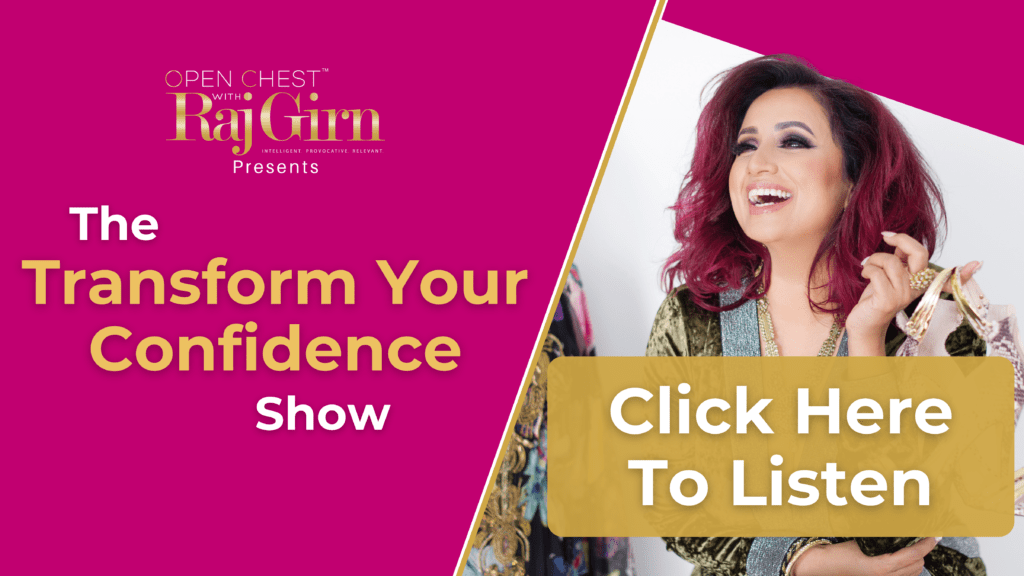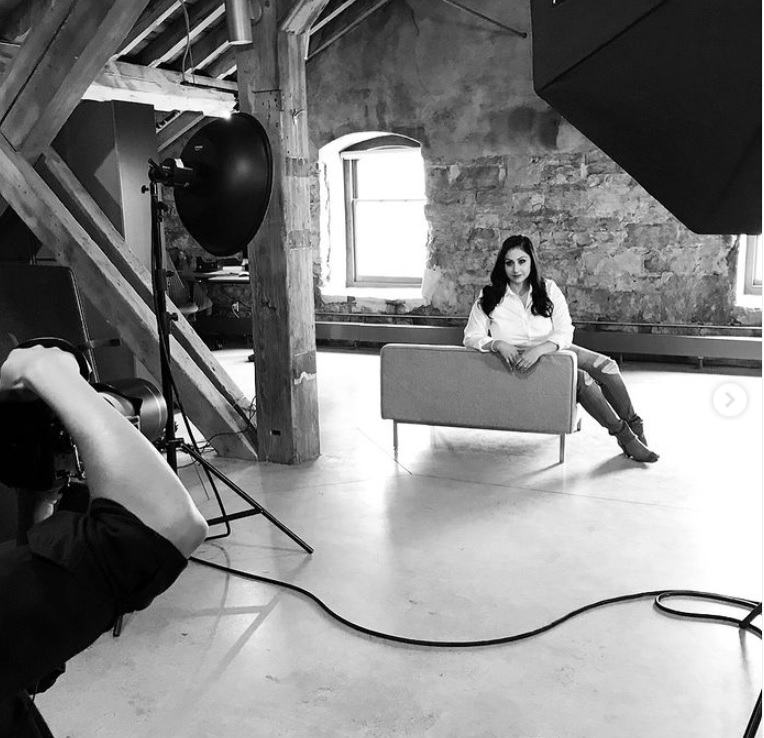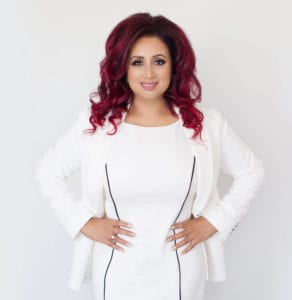Raj Girn: With this week’s theme of Media and Communications, the goal is to dissect the art and craft of good storytelling. My guest is award-winning journalist, former university professor, and the founder of VC Strategies, Veronica Chail-Gupta.
As a leading expert in organizational storytelling, strategic communications and media coaching, Veronica has more than 15 years of experience working in the Canadian media industry as a writer, news reporter, host and executive producer. After completing her Masters in Journalism from the University of Western Ontario, she got her start as a news reporter/writer for OMNI Television and also hosted a lifestyle talk show called In Toronto on Rogers Television. She then went on to work as a TV producer at the CBC for The Hour with George Stroumboulopoulos. For five years following this, Veronica was the face of Canada’s national Bollywood TV Series Bollywood Blvd., on OMNI and Citytv, where she interviewed Bollywood’s biggest stars. Following this, she became a professor at Seneca College and Ryerson University, while forming her start-up, VC Strategies, where she helps entrepreneurs and executives with their storytelling needs.
Here is Part One of our conversation:

Raj Girn: Folks, thanks for tuning into another great two-part series of the Transform Your Confidence show. I’m your host, as always, Raj Girn, the founder of TheOpenChestConfidenceAcademy.com. This week’s theme is Media and Communications, and I’ll be breaking down the art and craft of great storytelling, which is at the crux of building authentic and credible connections with stakeholders who could be people you work with, clients, prospective clients, followers, fans, even the media. Should you be looking to build a public persona? To help me do this my guest is award-winning journalist, former university professor, and the founder of VC Strategies, Veronica Chail.
Veronica has worked both behind and in front of the cameras as a producer and as a host for entertainment news and corporate storytelling, and comes with extensive and diverse experience in creating visceral connections with virtual audiences. Please welcome to the show my girl Veronica Chail. Thanks so much for agreeing to be on the show, sweetheart. I have been waiting to have this conversation, deep dive storytelling with the one person I feel is better at it than anyone else in my repertoire. And I know a lot of people, as you know. Thanks for being on.
Veronica Chail: Thank you so much. It’s an honour to be on here with you today.

So please, folks, my goal with this two-part series is to help provide you with some clarity in the deafening maze of content overload to carve out your story and your message so that you can stand out in your own right and be heard, seen, and respected for what you do. So let’s just jump right in. V, I have got to ask you this. Folks, by the way, when you hear me say V. that’s because I’ve known I know this incredible lady for the last two decades. So Veronica Chail-Gupta is her name. But if I keep slipping and calling her V, you know, because I love this lady and we have a very personal connection as well as our many years of working together in the biz. So Veronica, let’s start by giving everyone some context. What is storytelling? Because we talk about storytelling. It’s all out there. It’s been kind of the big buzz word for the last decade since social media really kind of came into its own. But a lot of people don’t do it right. So I kind of want to start with contextualizing what actually is storytelling.
Well, first and foremost, I want to say I treasure our bond. I treasure our friendship and our relationship. And you and I have endless stories to share with the world and so many for the books. But to get into storytelling, which is just everything in my DNA; I got into journalism because of storytelling. So storytelling in a nutshell is how and why life changes. It doesn’t necessarily have to mean once upon a time, it doesn’t necessarily have to have a beginning, middle and end. It’s just simply how and why life changes in terms of conveying a narrative. So just to put it simply, you can be living a relatively normal life, going about your day, going to work, celebrating a big birthday and then all of a sudden a pandemic hits the next day, which is what’s happened to many people. And life changes course. And there’s a lot of loss. There’s a lot of joy. There’s a lot of struggle. And we basically speak to those stories with a human face. And so storytelling really answers how and why life changes. It’s really putting humanity at the forefront of it.
“Storytelling in a nutshell, is how and why life changes. It doesn’t necessarily have to mean once upon a time, it doesn’t necessarily have to have a beginning, middle and an end. It’s just simply how and why life changes in terms of conveying a narrative.” ~Veronica Chail-Gupta
I love that. This was the context that you’re going to start this with. And the reason why it’s important is that if we don’t quite understand what storytelling is doing it becomes really difficult because there is so much noise out there in the storytelling space and a lot of people have different intentions with it. So let’s talk a little bit about that now. Why is storytelling important?
So storytelling is so important because it evokes emotion. Like, sometimes when we hear a story, you get a chill down your spine, you get goosebumps, you literally feel something you might hear, whether that’s a news story, whether that’s a fictional story, whether it’s a series on Netflix. This is why we stay up to 2:00 or 3:00 am watching these shows because of the humanity that stories convey. I always talk narrative over numbers. In business, when you’re talking about narrative, I remember stories over any statistics and I’m finding that even while we’re in a pandemic with COVID-19, and it is a health crisis every single day, we are inundated with numbers after numbers after numbers, and we can’t kind of conceptualize it. We can’t quite understand what it means, the graphs and the statistics, the global scale of it. And I think when you see the human faces, the unthinkable loss, the range in age of people dying, of people being affected by this pandemic, that’s when it hits you.

I mean, if you’re really following the pandemic, for example, from a news feed story. I’m always yelling at the TV, “Stop throwing out these numbers. No one understands this” because it’s the stories of people going through this, the doctors on the frontlines. I’m always yelling at the TV and my husband always laughs at me because I always say, “Why aren’t you interviewing the nurses, the ICU doctors, the people who are actually going through this and experiencing this?” Again, there’s so many different perspectives to the pandemic, and I don’t want to ignore the other aspects of it. But in terms of conveying that human story of what we’re experiencing, which is so much loss, it’s so important that we’re able to convey with human faces. And so I think even with respect to the pandemic or any cycles that are happening, you write like any business right now. You have a microscopic audience who’s watching you very closely because everyone’s paying attention because everyone’s in a lockdown.
Right. And everyone’s vested because, as you said, the art of storytelling, really the crux, the ground zero of it is, is it connecting with the emotions of a human? Now, what those emotions are is a whole other intention of storytelling, right? So let me ask you that then. How do people create stories that will pull at the emotionality strings? So in other words, what is the architecture of a good story? Now, I know that you could spend copious amounts of hours going into this, so let me give you context. If a person is in some sort of a business arena, what do they need to know about being able to create connection with their architecture of a story? What would that be?
So I think when it comes to business, and even with respect to my clients and some of the CEOs I talk to, they often talk in numbers and I often ask them, why do you wake up to do what you do? What makes you tick? When we look at different companies, for example Disney, the employees wake up to make people happy. Princess Margaret Hospital, the employees wake up to hopefully cure cancer. We have to know why you do what you do and to have a purpose. And to do that, we can certainly throw out PowerPoint presentations, some boring memos, which is very common. But if you convey a story as to why you do what you do, why you even started your business, it will resonate with people. And manifesting all the struggles, all the nastiness that is involved really relates to certain people. And I think the biggest thing in crafting and being a great architect of a great story or even storytelling within a business is you have to have self-knowledge. Self-knowledge is the root of great storytelling. If you understand your own humanity, you will understand it in others. And I think oftentimes a lot of leaders distance themselves because they take on that leadership hat and they throw up numbers and it becomes robotic because they take on these roles of I have to maintain my strength, I have to be in a leadership role.
“The biggest thing in crafting and being a great architect of a great story or even storytelling within a business is you have to have self-knowledge. Self-knowledge is the root of great storytelling.” ~Veronica Chail-Gupta
And the connection gets dismantled as a result, because people don’t see you as a human, they see you more as a robot. And it’s so important that when it comes to storytelling that people can relate to your emotional appeal and that they understand that the message you’re conveying is across the entire company. So there’s consistency. So when I even speak to many of my clients, it’s everything from the way you email your brand DNA, the way you communicate on social media, your tone, whether it’s first person or second person or third person, all of that has to be consistent because it has to relate back to who you are as a leader. And I think a lot of leaders know their own tasks. They often don’t even believe their own spin doctors. So why should the public? So if you start with an authentic story as to why you do what you do, what makes you tick? That’s going to resonate in the entire company.
Oh, my God, everything! All of the above, everything you just said there. Folks, if you’re just joining us, I am in conversation with the fabulous Veronica Chail-Gupta. She is the founder of VC Strategies and she is a long-time award winning journalist and producer. She has worked in the entertainment news and corporate scenarios, and she has perfected the art of storytelling. And that’s really what this show today is about. So I want to kind of get into a little bit of the tactical stuff, Veronica, without us going to minutia, if that’s even possible for you, but we’re going to try. I’m going to try and keep it top level.
So there are four main styles of storytelling narratives. And I feel that this is something that people get wrong a lot. A lot of my clients, when they come to me, half of their battle is knowing which narrative to tell their story in with the outcome that they’re looking to accomplish. So I’d love for you to share with linear, nonlinear quest and viewpoint, these are the four styles of storytelling narratives. Of course, there are many others that kind of come underneath them, but we’re going to keep it there because they’re the most common. Can you share the high level differentiation between them and perhaps illustrate each of them with an example? If you know there’s one that you can share with everyone just to kind of help those people out a little bit more visual to understand the difference between the four of them.
Yeah, so linear is obviously a chronological story. I shouldn’t say, obviously, because not everyone does know this, but it is chronological. So perhaps you are doing a start to finish. It could be a biography where you’re detailing everything that’s happened in your life. Non-linear is jumping around. And again, this is not necessarily in real-life format. It can also be fictional. You can start at the end and then unravel the different layers and then get to the beginning. At the very end, I mean, to the end of the non-linear chronological there is a quest, which is basically, it’s pretty self-explanatory, but it’s revealing. It’s almost like a sense of curiosity and unraveling of a story. I mean, it’s the character, the protagonist, going on a quest and revealing different parts of his or her story. And then viewpoint is very interesting because it depends on the viewpoint each character is taking. Or viewpoint is a very specific narrative where different characters can take different viewpoints in sharing the story from each perspective. So we’ve seen it in different shows where each story is told from a different viewpoint.

I love that. So let me ask you this then. Let’s go a little deeper with this. Within the context of the fact that we’re doing a show which is for professionals, executives, people who are very much looking at how they can include storytelling and the different styles of storytelling to an intention that is commercial and enterprise. So with that in mind, there are eight storytelling techniques which then gets even more complicated. Guys, there’s the monomyth, there’s the mountain, nested loops, sparklines, in medias res, converging ideas, the false start and the petal structure.
I’m not going to have you talk about all of them, but I am going to have you focus on the monomyth since it’s the most commonly used version in business. It is also, for those of you guys who don’t know, commonly known as the hero story. So what do people need to know about this style of storytelling so that they can nail their hero story? Because everybody in business talks about the hero story. And it is important because it kind of is that foundation of how you need to set up your brand for your business and the intention of the products and services and the different missions and initiatives that you get involved with. It’s very crucial that you nail that. So can you share from your perspective and kind of break that down for us a little bit?
Yeah. So that one is obviously the most popular and it’s great for presentations, especially when it comes to storytelling and presentations, which I’m always a big fan of. If you look at the hero version of storytelling, in this technique I often think of Steve Jobs or the late Martin Luther King. Oftentimes it’s a character protagonist, an individual who is going about daily life and in some type of normal setting. And something happens, whether it’s a struggle, a revelation, something happens. And oftentimes there’s a struggle and then they’re transformed. So it’s a story where there is a transformation and then there’s a relatability and there’s a lot of emotional output in terms of that transformation. So I often look at why we relate to someone. Why we relate to someone like Steve Jobs is because when we buy Apple products, for example, we are buying into Steve Jobs DNA. He has created a company culture based on his belief system of minimalism, simplicity and storytelling. And it’s incredible, even when he was presenting how he would portray that. I personally love the Lion King. People still resonate with that story because of what he goes through, what Simba goes through, the struggles and then him becoming who he does at the end. But it’s this story of this greatness, and he’s got all this privilege in the beginning and then the struggle and then what unravels in the story. And then at the end, he’s crowned king. So we can relate to that even in a Disney format.
Absolutely. And I love that you used that example. I was smiling when you mentioned that because that’s always my kind of go to Disney film. When I think about wanting to feel good about the struggles that I’ve gone through in my life I feel that it’s one of those few Disney stories that is animated that truly speaks to adults. I really do.
Yes. Yes.
We’ve talked a bit about what storytelling is, some of the kind of tactical benchmarks around storytelling. Now let’s see how we can create connection between storytelling and the commercial business world, like why it’s important. So let me ask you this. How does good storytelling authenticate a brand?
So if you don’t control your narrative, someone else will, with a lot less flattering results and fair or unfair stories shape corporate futures. And that is my genuine belief. I often believe that even when we are in meetings or on these Zoom calls, which everyone’s on these days, we’re constantly inundated with statistics, numbers, bullet points, memos, and it’s almost like it goes over your head in a way. It doesn’t resonate. It doesn’t make you feel. And I think when you humanize a profession, whether it’s architecture, engineering, the legal world, even if you think it’s complex and you can’t humanize these things, we’re talking about people. At the end of the day, we’re just human beings. And I think where we take on these masks, we take on these titles, we take on these labels.
“If you don’t control your narrative, someone else will, with a lot less flattering results and fair or unfair stories shape corporate futures.” ~Veronica Chail-Gupta
And even when you’re applying for a job, the description, the job descriptions are so robotic that there’s a lack of connection with creativity. So for me, the only way to do it is to humanize profession, to really understand how are you communicating to your audience and how is your audience receiving your message and anything that you do. And so that’s something we do that I work on with my clients, which I love, is that we marry journalism and PR principles so that we are able to share the company the corporate story and then also do organizational storytelling within the company so that the team members also understand the heartbeat of a company, the brand DNA. What makes this company tick?
I love everything about what you said and I stand by that. As someone that is a business owner, has been in business and entrepreneurship and in that very kind of disruption industry, that media, communications, events, all of the above. We’ve seen so much kind of technological disruption happen, so much change happen in people’s abilities to be able to communicate their message without having to go through media houses and communications companies. Because we have social media today. It’s changed the landscape and kind of flipped the dynamic of power from traditional media houses to the everyday man. And that is a whole other subject matter.
And I think that’s why storytelling and getting it right and being intentional is really important. Also today, more than it ever has been because of the fact that everybody has the tools and the ammunition to tell that story. So let me ask you this question. Can you break down how the way you tell a story differs depending on intention? For example, if the story is for entertainment purposes, to inform people of something, to sell people something or even to advocate a mission or a mandate, how do you do this? And is there a difference between each of these?

Absolutely. I mean, when I work with great individuals that I get to work with, I basically psychoanalyze their organizations and companies because I do feel like I want to understand why they do what they do. And I keep going back to that because you have to understand your purpose and then you can formulate a strategy. And the strategy for me, I go by this and this is our motto in our company is that storytelling is the best strategy. So when you’re talking about entertainment, let’s talk entertainment. You have to talk. Do you go first person versus third person? Is it going to be something more raw and candid? You have to talk about tone, diction, imagery, the relatability, what platforms you’re going to be utilizing, if you’re going to target media. Are you advertising, are you not advertising? When it comes to something that may be with respect to advocating, it’s something that has to relate to. Obviously, there’s a struggle oftentimes with respect to advocating for different issues and so forth.
We’re seeing obviously with the Black Lives Matter movement being reignited, we’re hearing about the destructive residential schools. When we’re advocating for different communities, we have to really empathize and have compassion and to really walk in their shoes and stand with them in solidarity. So there’s different messaging. But when you break it down, there is a lot of crossover when it comes to the storytelling, whether it is, again, something that you’re celebrating, whether it is a story of struggle and you’re trying to come up with some type of healing, whether you’re trying to raise money, there is differentiation for sure. And it depends on how you want to go in with the messaging. And that’s why there is a big difference between infomercials, commercials and storytelling. I think there’s a very big difference because I think the public knows when you’re trying to sell them something versus someone just simply sharing a story which again, can be received in a branding selling way as well. So there’s different ways of going about it, for sure.
Absolutely. You just touched upon something that I want to kind of reignite. And this is why the most authentic way folks of selling something is to have a story. And this is why I decided out of the eight different ways that you can really put a story out there that the hero story one was the one that I wanted to just kind of deep dive a little further with Veronica because that really is the tried and tested methodology of ensuring that you stay authentic, that people and you and that authenticity helps you connect with the right person. The other key here is that you know, what’s your intention to tell a story? If your intention is to sell something you need to ensure that your story is connecting with the person that wants what you’re selling. And this is why the hero story isn’t a story that is the story of your life. It’s the component of the story of your life that takes a person on the journey to that sell.
So that’s the important thing I feel when a lot of my clients come to me and know that this is something that happens with you as well V, is that they feel that the hero story is the story of their life. People only have a certain amount of capability to understand where you’re trying to take them. So you have to be intentional with telling that story. So I love everything that you shared there. So this kind of brings me to my next question. When a story is being presented, and you mentioned this already, it can be done in first, second or third person. Can you define for anyone out there that doesn’t really know the difference between the three of them? Can you define what each is and when you might use one over the other?
“People only have a certain amount of capability to understand where you’re trying to take them. So you have to be intentional with telling that story.” ~Raj Girn
First person is the the main character speaking in the first tone. So “Hi, my name is Veronica Chail-Gupta. I am x years old and this and that. So it’s using I. Second person is the reader takes on the role of the character so the reader becomes you and then the third . . . Which you don’t see second person very often. And then the first person, I’ll give you an example of first person is like The Great Gatsby, for example, the narration. And you know, it’s this incredible story. Or To Kill a Mockingbird is another one for first person. Third person is we speak and the narrator speaks on behalf of the main character. So I would say Raj Girn has twenty five years of experience doing X, Y and Z. She’s a media mogul. She’s this this this, is a philanthropist, a humanitarian at heart. And I’m speaking on behalf of you. So that’s third person. And we often see a third person using biographies and we see this in company profiles. We see this in speech writing. We see this in introductions, even though we know the person has written their own bio, likely it’s being said in a third person. So there’s a bit of distance oftentimes now.

And if you really want to get closer to your audience, you use first person to say “Hi, my name is Veronica Chail-Gupta. I am a journalist turned professor turned communication strategist and I have x number of years of experience. This is what I do and I want to help you do X, Y and Z. Or I could do the third person tone and be a little bit more distant. Professionally speaking, we often use third person in bios. We use it in pretty much a lot of stuff. Social media, however, has brought us to first person where there is this immediate access in storytelling that we’re raw and candid and unfiltered, which is not very true. But that’s the idea that we’re trying to convey, is that I’m speaking to you one-on-one, you have straight access to me, and so I’ll speak first person to you.
To contact Veronica Chail-Gupta: Instagram,Twitter, Linkedin, Mail












